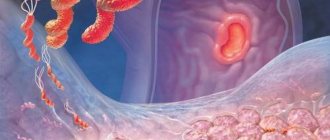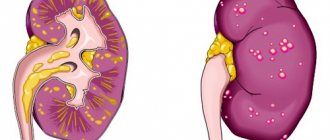Attention! Self-medication is strictly prohibited. After a detailed diagnosis and confirmation of the diagnosis of “calcifications in the spleen,” the patient needs to consult a doctor about folk remedies; perhaps the clinical picture will require therapeutic intervention.
If calcifications are diagnosed at an early stage, then the patient needs to adjust his diet and adhere to a special diet, which includes avoiding fried foods, sweets and starchy foods, fatty foods, and canned foods. Also, do not overuse coffee and strong black tea.
Video - Multiple calcifications of the spleen
What are calcifications in the spleen?
Calcification in the spleen can be caused by both direct tissue damage and metabolic diseases. The most common form is dystrophic calcification. Calcification tends to occur in the second half of life; The tumor type usually occurs in the 1st or 2nd decade of life.
Classification
Excessive intake of vitamin D from food is the most common cause of splenic calcification in children.
In medicine, there are two types of calcification:
Dystrophic calcification appears in ischemic or altered tissues - with necrosis, preserved exudates and arteriosclerosis. In these tissues the pH is greatly reduced, so the body's physiological response is to precipitate calcium. The problem is that calcification can impair the function of the spleen. Calcifications (synonym: calcifications) are deposits of calcium salts in degenerated or dead cells. Macroscopically, calcifications have the appearance of whitish granulations of variable size. The functional consequences depend on the size and shape of the calcifications.
Metastatic calcification may occur due to hyperparathyroidism, hypervitaminosis D, or accelerated bone destruction. In this case, calcium enters the bloodstream from other tissues and is then deposited in the spleen. In children, the most common cause of calcification is excessive intake of vitamin D from food.
Symptoms
Symptoms can vary greatly. In some patients, calcification may be asymptomatic. In more rare situations, the spleen may become enlarged and severe pain may occur in the left upper quadrant of the abdomen.
The clinical picture of calcification (calcification) is characterized by macroscopically visible and palpable tumors. Local inflammation often occurs. Sometimes autosplenectomy is observed - wrinkling and reduction in the size of the spleen, which leads to its complete dysfunction.
Causes
One of the reasons for the development of this pathology may be a previous infectious disease.
Tissue necrosis that occurs in response to an infectious disease can lead to calcification of the spleen. Some infectious granulomas produce 1,25-vitamin D. Infections that can lead to calcification include onchocerciasis, cysticercosis, histoplasmosis, and cryptococcosis. Often, calcifications can also appear in other organs - the pancreas or liver.
Benign and malignant tumors can lead to the formation of calcifications in the spleen. Epithelial cysts and syringomas can also increase the risk of developing calcifications in the abdominal organs in the long term. In rare cases, melanocytic nevi, malignant melanoma, atypical fibroxanthoma, hemangioma, suppurative granuloma, seborrheic keratoses, neurilemomas and trichoepitheliomas can lead to the formation of calcifications in the spleen or nearby organs - the pancreas.
Causes
- Inflammatory process of the spleen parenchyma. The ingress of infectious agents with blood or lymph leads to inflammation of the organ tissue, a compaction is formed, which quickly turns into a purulent stage. At the site of purulent melting, after resolution of the process, partial tissue necrosis forms. Calcium salts begin to migrate into the necrotic tissue, accumulating and forming microcalcification, which can subsequently grow to a more impressive size.
- Injury to the splenic parenchyma due to falls from a height, impacts. The mechanism of stone formation is similar to the previous one. In this case, the cause of partial tissue necrosis is mechanical trauma (bruise, compression, tissue rupture), calcium salts are added and calcifications are formed.
- Failure in the process of calcium metabolism - increasing its level in the blood (hypercalcemia). This happens for a number of reasons:
- increased production of hormones by the parathyroid glands that are responsible for increasing calcium levels in the blood (hyperparathyroidism);
- some oncological diseases that provoke the leaching of calcium from the bone into the blood;
- sarcoidosis;
- certain endocrine disorders (diseases of the thyroid gland, adrenal glands);
- indiscriminate use of certain medications (thiazide diuretics, lithium preparations, calcium preparations);
- overdose of vitamins D and A;
- long-term immobilization due to any mechanical injury (fracture of the spine, pelvis, hip, both bones of the leg);
- intestinal diseases as a result of intestinal operations;
- excessive destruction of formed elements in the blood.
Diagnostics
If you suspect the presence of salt deposits in the spleen, an ultrasound examination is performed (it allows you to determine the exact size of the deposits, location and quantity)
Diagnosis is based on clinical presentation, history, and imaging studies. To confirm a suspected diagnosis, a biopsy is recommended. Laboratory testing of a tissue sample reveals calcium phosphate. The key to diagnosis is to identify the underlying cause of the calcification. The prognosis of patients depends on the underlying disease; the same applies to therapy.
Bone metastases
The cause of increased calcium levels in the blood may be metastases of the skeletal system. Notably, they often develop in parallel with cancer:
More often, metastases appear in the spine and are accompanied by pain. Symptoms of excess calcium include:
- Memory impairment.
- Depression.
- Pain in muscles and joints.
- Weakness.
- Vomit.
- Nausea.
- Cholelithiasis.
- Kidney problems.
- Arrhythmia.
- Cataract.
- Skin itching and so on.
Treatment
Treatment methods depend significantly on the cause and location of calcifications in the spleen. If multiple organs are affected, this may indicate more severe calcification. In some cases, the disease can cause kidney, stomach or lung dysfunction.
Calcifications in the spleen do not disappear without treatment. For this reason, medical treatment is required in all cases to avoid further complications and symptoms. A doctor should be consulted when it comes to excessively severe pain. Most patients also suffer from inflammation or swelling. If severe inflammation occurs for no particular reason, a doctor's examination is also necessary. Diagnosis of the disease can usually be made by a general practitioner. Further treatment depends on the cause, as well as the exact complaints.
In rare cases, surgical removal of calcium deposits from the spleen is required. Often surgical treatment can be performed under local anesthesia. If other organs are involved, more complex surgery may be required. In addition to general anesthesia, the surgical procedure must be carefully planned, which is usually performed using imaging techniques such as MRI.
Acute hypercalcemia can often be corrected by administering loop diuretics and glucocorticoids as they support renal excretion of calcium. In some cases, it is impossible to prescribe a causal therapy, so treatment in these cases is purely symptomatic. The same applies to idiopathic calcification, the cause of which cannot be identified.
Bisphosphonates are used to reduce serum calcium and phosphate concentrations. The drugs can also absorb the hydroxyapatite crystal and inhibit its growth. Etidronate disodium reduces bone formation and does not alter calcium reabsorption. It has no effect on hypercalcemia in patients with hyperparathyroidism.
Signs of the disease
A distinctive feature of this little-studied organ is that any diseases occurring in it do not manifest symptoms. There are no pain receptors on the surface of the spleen, so diseases are not accompanied by pain sensations there. As a result, diagnosing organ diseases is very difficult.
Indirect factors that can be regarded as signs of pathological changes include:
- increase in size (in normal conditions, the spleen is not palpable during a manual examination by a doctor, but in the event of diseases of this organ, or concomitant diseases that have a negative impact on it, it responds with an increase in size);
- decreased immunity (and, as a consequence, recurrent course of infectious diseases);
- anemia (when diseases occur, the spleen enlarges and begins to absorb a large number of red blood cells, destroying them, which causes anemia);
- low blood clotting (the result of increased work of the diseased organ to dispose of supposedly unnecessary platelets - due to illness, the spleen loses the ability to adequately filter healthy and diseased blood cells);
Localization is not pronounced, this is due to the fact that the organ itself does not hurt, it enlarges, compresses nearby organs and this causes pain in all organs surrounding the spleen.
Why does the gallbladder bend: treatment.
Gallstones, what to do, how to treat?
Diagnostics
Diagnosis of organ diseases is carried out by a general practitioner in the following ways:
- manual examination (if the organ is palpable, this indicates its significant enlargement, and therefore pathologies);
- taking an anamnesis (it is necessary to ask the patient in detail about the nature and localization of unpleasant sensations);
- X-ray examination;
- puncture (performed when there is a significant increase and there is a suspicion of a cancerous tumor due to the danger of the method);
- blood test.
The spleen - what kind of organ it is and doctors talk about its main functions, watch the video:
Rehabilitation
After treatment, regular visits to the doctor are required to avoid new complications
If complications arise, the patient needs to undergo rehabilitation treatment. The patient should avoid recurrence of the disease in any case and find out the cause of calcification. Surgery is usually uneventful and does not require hospitalization, so no follow-up care is required. Even after treatment, regular visits to the doctor are necessary to avoid further complications. The disease can be partially controlled with medication.
In some cases, causal therapy is not possible, so only symptomatic treatment can be prescribed. The disease usually does not affect the patient's life expectancy.
Forecast
The underlying disease, as well as the degree of prevalence of calcifications, are important for the prognosis of the patient's condition. Many patients do not improve their symptoms during therapy because they are diagnosed with chronic diseases or systemic disorders. In many of these patients, calcium levels in the body are treated and monitored with long-term therapy. Surgery in most cases can effectively reduce the symptoms of the disease.
With a progressive underlying disease, despite the removal of calcium, recurrent symptoms occur. Surgical removal of calcifications should be carried out throughout life. Metabolic disorder can be treated effectively with medications. However, in this case, recurrence of organ calcification is also very likely. If calcification develops as a result of infection, the prognosis is good.
In most cases, the patient's discomfort in the spleen area decreases after surgery and removal of calcifications. If there are no complications, the patient is released from treatment within a few weeks. The prognosis is less favorable if the cause of calcification is tumors or tuberculosis. Despite numerous medical advances, calcifications can pose an immediate threat to human life.
Clinical picture
Due to the fact that the presence of calcifications in the spleen does not cause severe disturbances in the human body, diagnosing their presence is quite difficult. There are no specific complaints for this condition. Also, the general condition of the patient remains satisfactory. If there is an underlying disease, the patient may present corresponding complaints. The presence of calcifications in the spleen is revealed during an examination for another disease.
When calcifications grow in size, nonspecific complaints may appear. They arise due to damage to blood vessels located on the surface of internal organs, as well as during necrotic processes in tissues. Patients are concerned about:
- Nausea, possible vomiting
- Fatigue
- Weakness
- Drowsiness
- Headache
- Discomfort in the left hypochondrium
Similar symptoms are characteristic of many diseases. Therefore, if the above-described complaints occur, it is necessary to consult a doctor to diagnose spleen pathology.
When large calcifications form, it is possible to impair the blood circulation of the organ's vessels, as well as the development of tissue necrosis. The clinical picture of this complication is accompanied by:
- Sharp pain in the abdominal area
- Increased body temperature above 38
- Development of intoxication syndrome (weakness, sweating, chills, body aches)
- Tachycardia
- Unsteady stool
The appearance of these symptoms serves as the basis for hospitalization and treatment in a hospital setting.
Calcifications in the spleen. Description of the disease, causes, symptoms and treatment
Unfortunately, no one is immune from the appearance of various ailments. For example, many people are concerned about the question: calcifications in the liver and spleen - what is it? Let's try together to understand the features of this pathology.
What are calcifications?
Calcifications in the spleen are salt deposits of various sizes that form during inflammatory processes. It is extremely common to observe a situation where the lower part of this formation softens and turns into a cyst.
Causes of the disease
Calcifications in the spleen appear as a consequence of inflammatory processes in the body. That is, this disease is a secondary phenomenon, and in order to prevent it, it is enough to know the basic prerequisites and causes of its occurrence. The disease develops:
Regardless of the cause, in most cases this pathology does not require any treatment, but in some situations it is simply necessary, because chronic diseases may begin to worsen and previous ones may return.
Diagnostics
Symptoms
In the case when the calcifications transform into a cyst or become quite large in size, the patient may complain of the following symptoms:
- pain in the left side under the ribs;
- nausea and, in severe cases, vomiting;
- fast fatiguability;
- sleep disturbances and drowsiness;
- headache.
Calcifications in the spleen: treatment
If a person does not complain of ailments or the specialist does not notice complications during various types of examinations, the disease is not treated.
The most dangerous complication that calcifications in the spleen can cause is blockage of blood vessels. This pathology can lead to serious consequences. During diagnosis, it can be identified by the following factors:
- large salt accumulations;
- venous vessels become greatly enlarged and dilated.
When these signs appear, surgery is usually performed, during which the spleen is completely removed.
Traditional methods of treatment
If calcifications in the spleen were detected in the early stages, you can try to get rid of them without surgery or surgery. In this case, the possibility of their safe removal and scarring increases significantly.
The most effective recipes for this are as follows:
If calcifications in the spleen were detected in the early stages, the development of the disease can be prevented with the help of a special diet, during which you should refrain from starchy, sweet, fatty meats and fish, spicy foods, smoked meats, and various canned foods. It is also not recommended to drink coffee and too strong tea often.
Prevention
There are no special preventive measures, since the causes of calcifications are quite diverse, and it is impossible to prevent everything. The patient should monitor his health, and it is advisable to undergo an examination annually.
All inflammatory and infectious diseases must be treated promptly and completely. If you experience pain, heaviness on the left side below the ribs, or other symptoms that cause discomfort, you should go to the hospital. These signs may indicate not only calcifications, but also tumor formations in the spleen.
The prognosis for calcinosis is favorable if the cause of the stones is found and eliminated. If you do not seek treatment for severe symptoms, severe complications can occur that can only be eliminated by surgery.
Author: Oksana Belokur, doctor, especially for Zhkt.ru
ProTrakt.ru
Formation of calcifications in the spleen
Calcifications in the spleen accumulate in the same way as in other organs, for example, in the kidneys, lungs and even the liver, which is the body’s natural filter.
Calcifications are not an independent disease, but they serve as a clue that pathological changes have occurred in the body.
Therefore, deposits of calcium salts are not treated, but rather they try to get rid of the reasons that caused their formation in the structure of any internal organ.
Salt deposition in the spleen
As mentioned above, calcifications are a symptom accompanying a serious inflammatory disease.
Therefore, if a patient is diagnosed with an accumulation of calcifications in the spleen, then treatment of the patient is not started until the causes preceding their formation are identified.
By themselves, calcifications accumulated in the spleen do not pose a danger, but despite this, it is very important to understand in time what triggered their formation. In this way, it will be possible to increase the chances of avoiding relapses of the disease.
Salts accumulated in the tissues of the spleen on an x-ray may resemble oncological formations, so if they are detected, the doctor prescribes a number of additional examinations to the patient.
Usually, with a single formation, the pathology has nothing to do with oncology, but there are still cases when accumulations of calcifications in the spleen indicate the initial stage of oncology development.
It is difficult to find out about the presence of calcifications in the spleen, because a person’s well-being does not say anything about it. In a particular case, only a symptom of the underlying disease can make itself known.
The reasons for the formation of calcifications in the spleen are often a violation of phosphorus-calcium metabolism.
Their appearance is also caused by previously suffered infectious diseases, for example, pseudotuberculosis and yersiniosis.
After calcium salts accumulate in the spleen, they can block the vessels in the organ, resulting in impaired blood flow.
If this happens, the blood vessels of the spleen and the organ itself increase in size. Usually this condition does not cause discomfort to a person, so he does not need treatment.
But if the caused pathological changes are painful, then such a patient is often prepared for surgery.
Salt deposition in the liver
The reasons for the formation of calcifications in the liver are the same as in the above case. Calcium salts begin to be deposited in the liver if a person has suffered from diseases such as tuberculosis, hepatitis, echinococcosis, etc.
Calcifications begin to accumulate in those parts of the organ where inflammation has caused changes in its tissues.
Even more often, salt deposition in the liver is observed in people whose bodies are clogged with toxins. To get rid of toxins and prevent the formation of calcifications, doctors recommend drinking 1.5 - 2 liters of plain water every day.
It is difficult to find out when and why salts formed in the liver without the necessary examination. As a rule, the presence of salts in the body is discovered accidentally; for example, this can happen during an examination of an internal organ with an ultrasound machine.
In this case, the monitor screen shows that there are dense textures in the liver tissue. Sometimes such formations cause suspicion of oncology - a detailed study of the patient’s condition can refute this fact.
If calcifications do not impair liver function and do not spread throughout the organ, then treatment is not prescribed. If necessary, drug treatment is used to get rid of calcium salt deposits.
For example, during the treatment of calcifications in the liver, intravenous infusions of infusion solutions are prescribed.
But such procedures are carried out only after passing the necessary tests and ultrasound. The treatment course lasts at least two months and is accompanied by a diet.
During the treatment of this form of the disease, foods high in cholesterol, as well as animal proteins and fats, are excluded from the patient’s menu.
At the same time, the patient needs to eat often, at least 5 times a day, but little by little, which will normalize the flow of bile and prevent its stagnation.
The patient's diet should consist of seasonal fruits and vegetables; daily consumption of fresh herbs has a good effect on the functioning of the liver. Sea fish, lean meat and dairy products - this is what the patient’s menu should consist of.
Diagnosis and prevention of calcifications
As mentioned above, it is quite difficult to calculate the presence of accumulations of calcifications in the body.
But since the formation has a structure similar to human bone, it can be detected in the tissues of internal organs using an x-ray examination. On an x-ray, calcification will appear as a stone-like growth.
If more detailed diagnosis is required when treating a patient, then magnetic resonance or computed tomography is used.
The examination method used will help not only to determine the location of salt accumulation, but also to determine their value.
Ultrasound, contrary to the opinion of many, is used by specialists not to detect calcification, but to confirm or refute the presence of inflammation in the kidneys, liver, spleen and other organs.
If the examination showed that calcifications affected several organs at once, and the reasons that provoked such a condition remained unidentified, then doctors are required to prescribe such a patient to donate blood for a biochemical analysis.
This sign may be a symptom of hypercalcemia (an increase in the concentration of calcium in the blood plasma), which at the initial stage of development most often has a latent form.
As for the prevention of calcifications, the basic principles for preventing such a condition have not yet been developed.
This fact is explained by the fact that there are plenty of reasons for the appearance of salt deposits.
The only general rule that should be followed for preventive purposes is the timely and complete treatment of any inflammation that occurs in the body.
Diagnostic measures and their effectiveness
It makes no sense to purposefully look for calcifications in the body, including the spleen. They are found either by accident or in the presence of specific symptoms.
It is possible to visualize calcium stones only using instrumental methods; laboratory diagnostics in this case are not informative. Additional blood and urine tests are within the absolute normal range, except in cases where there is concomitant pathology. The simplest and least labor-intensive method is x-ray diagnostics. With the help of an x-ray, it is possible to see only the formation.
The nature of the tumor can be determined using computed tomography (CT), magnetic resonance imaging (MRI) or ultrasound diagnostics (US). The possibility of these studies is very wide; it allows us to clarify not only the location, but also the shape and size of the calcification, the presence of nearby vessels and nerves.
Multiple calcifications found in the spleen prompt the appointment of methods for examining other parenchymal organs, because this may be a sign of a systemic disease. Further careful examination of the person is necessary to identify the cause of the appearance of calcium stones. In this case, it is necessary to do additional tests (clinical and biochemical analysis of blood and urine), conduct an examination of the kidneys, liver, thyroid gland, stomach and intestines.
Calcifications in the spleen. Description of the disease, causes, symptoms and treatment
Unfortunately, no one is immune from the appearance of various ailments. For example, many people are concerned about the question: calcifications in the liver and spleen - what is it? Let's try together to understand the features of this pathology.
What are calcifications?
Calcifications in the spleen are salt deposits of various sizes that form during inflammatory processes. It is extremely common to observe a situation where the lower part of this formation softens and turns into a cyst.
Causes of the disease
Calcifications in the spleen appear as a consequence of inflammatory processes in the body. That is, this disease is a secondary phenomenon, and in order to prevent it, it is enough to know the basic prerequisites and causes of its occurrence. The disease develops:
Regardless of the cause, in most cases this pathology does not require any treatment, but in some situations it is simply necessary, because chronic diseases may begin to worsen and previous ones may return.
Diagnostics
Symptoms
In the case when the calcifications transform into a cyst or become quite large in size, the patient may complain of the following symptoms:
- pain in the left side under the ribs;
- nausea and, in severe cases, vomiting;
- fast fatiguability;
- sleep disturbances and drowsiness;
- headache.
Calcifications in the spleen: treatment
If a person does not complain of ailments or the specialist does not notice complications during various types of examinations, the disease is not treated.
The most dangerous complication that calcifications in the spleen can cause is blockage of blood vessels. This pathology can lead to serious consequences. During diagnosis, it can be identified by the following factors:
- large salt accumulations;
- venous vessels become greatly enlarged and dilated.
When these signs appear, surgery is usually performed, during which the spleen is completely removed.
Traditional methods of treatment
If calcifications in the spleen were detected in the early stages, you can try to get rid of them without surgery or surgery. In this case, the possibility of their safe removal and scarring increases significantly.
The most effective recipes for this are as follows:
If calcifications in the spleen were detected in the early stages, the development of the disease can be prevented with the help of a special diet, during which you should refrain from starchy, sweet, fatty meats and fish, spicy foods, smoked meats, and various canned foods. It is also not recommended to drink coffee and too strong tea often.
Article rating:
Calcifications in the spleen causes symptoms treatment Link to main publication
Related publications
- How is liver resection performed?
Symptoms
Clinical symptoms of the disease depend on several factors: the size of calcifications, their number and location. If this is microcalcification of the spleen, then the person will not find any signs of health problems.
However, if the size of the spleen calcifications is large, then they are able to compress nearby blood vessels (arteries or veins), thereby disrupting the blood circulation of the organ. Another variant of the course of salt stones is the high probability of the formation of cysts from them. In the above cases, the following symptoms may occur:
- a feeling of heaviness or pain in the left hypochondrium, the pain is aching in nature, not acute;
- mild nausea is possible, less often accompanied by single (rarely multiple) vomiting;
- slight increase in body temperature;
- weakness, lethargy, headache, sweating.
The severity of symptoms can vary, from a mild, almost imperceptible health disorder to severe clinical symptoms with high fever.











